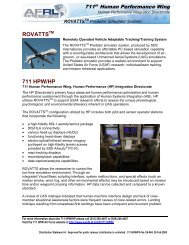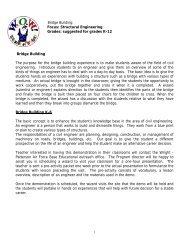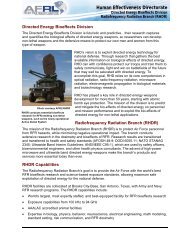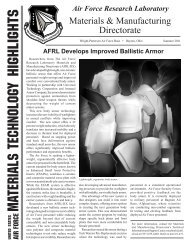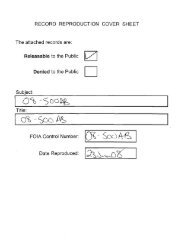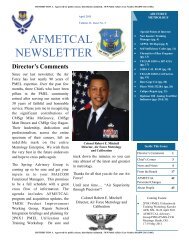TO 00-20-14 30 SEPTEMBER 2011 - Wright-Patterson Air Force Base
TO 00-20-14 30 SEPTEMBER 2011 - Wright-Patterson Air Force Base
TO 00-20-14 30 SEPTEMBER 2011 - Wright-Patterson Air Force Base
- No tags were found...
Create successful ePaper yourself
Turn your PDF publications into a flip-book with our unique Google optimized e-Paper software.
<strong>30</strong> September <strong>20</strong>11 <strong>TO</strong> <strong>00</strong>-<strong>20</strong>-<strong>14</strong>3.1.7.1 Locally Developed Procedures. Locally developed procedures for items designated PMEL responsibility shallnot be used to perform calibration until approved by AFMETCAL and the using command (<strong>TO</strong> <strong>00</strong>-5-1). Format of theprocedures shall conform to MIL-PRF-38793 and MIL-STD-38784. The writing shall conform to the plain Englishstandards and minimum editorial requirements listed in AFI 33-360. The local procedures shall be routed through thePMEL’s MFM to AFMETCAL. If a locally developed procedure must be changed or revised, the revised locallydeveloped procedure shall be routed through the PMEL’s MFM to AFMETCAL for approval prior to use. Do not submitAF<strong>TO</strong> Forms 22 for locally developed procedures.3.1.7.2 Procedure Specifications. 33K Series calibration procedures shall be written to meet manufacturer'sspecifications whenever possible. The procedure shall direct use of a Limited Certification Label if the parameters listedin Table 1 of the calibration procedure do not meet the manufacturer's specifications. This is to ensure the user of theTMDE is made aware of the deviations from manufacturer's specifications. Table 1 specifications of 33K Series <strong>TO</strong> takeprecedence over other specifications or tolerances listed throughout the <strong>TO</strong>. Individuals discovering contradictionsbetween Table 1 and any other section of the <strong>TO</strong> shall comply with paragraph 3.1.8. Manufacturer’s typical (oroperational) specifications generally indicate the manufacturer’s expected performance of a given product and are notwarranted or guaranteed by the manufacturer. Specifications listed as typical in Table 1 will not normally be calibrated(nor require a limited calibration) unless directed by Section 4 of the calibration <strong>TO</strong>.3.1.7.3 <strong>TO</strong> Verification Process. Laboratories shall perform <strong>TO</strong> verification on all draft calibration procedures (manualand/or automated) received from AFMETCAL for review. Guidelines detailing the verification process are outlined onthe AF Portal, Metrology & Calibration, Products & Services, <strong>TO</strong> Support, <strong>TO</strong> Support Home, <strong>TO</strong> Verification, <strong>TO</strong>Verification Checklist.3.1.7.4 Post-Publication Reviews. AFMETCAL will perform Post-Publication Reviews on <strong>TO</strong>s under any of thefollowing conditions:a. The <strong>TO</strong> has not been changed for five years.b. The recommendation of the Technical Content Manager (TCM).c. The recommendation of the <strong>TO</strong> Manager due to the number of AF<strong>TO</strong> 22s received and at the request of theusing command Functional Manager.During a Post Publication Review, one or several PMELs may be tasked through the Command MFM to participate,either locally or at another site. This tasking shall be at the discretion of the TCM. Reference AFMCI 21-<strong>30</strong>1, <strong>TO</strong> <strong>00</strong>-5-1, and <strong>TO</strong> <strong>00</strong>-5-3.3.1.8 Documenting and Reporting Procedure Problems. PMEL technicians experiencing difficulty performingcalibration procedures shall contact the appropriate AFMETCAL branch for assistance and submit an AF<strong>TO</strong> Form 22,Technical Manual Change Recommendation and Reply, if necessary. When a calibration procedure (33K) contains anerror that prevents successful calibration and an AF<strong>TO</strong> Form 22 is submitted, the technician shall select an alternateprocedure for the affected parameter(s) in compliance with paragraph 3.1.2, and document the calibration authority for theaffected parameter(s) in the Special block of the certification label. If commercial data is used, document its use inaccordance with paragraphs 5.4.2.3.2 and 5.4.2.3.2.1.3.2 EXCEPTIONS FROM PERIODIC CALIBRATION.Some types of TMDE do not require periodic calibration. They include items not used to make quantitativemeasurements, TMDE seldom used but must be calibrated before use, items designated as not requiring calibration andTMDE that requires initial calibration only.3.2.1 No Calibration Required (NCR) Items. Certain types of TMDE identified as NCR do not require calibrationbecause they do not provide important quantitative measurement information, and/or are accessories to other TMDE orfunction only as an interface device. Examples are RF receivers traceable to a frequency standard; some automotive testequipment; some pressure regulators, isolators, terminations, loads, adapters, tees, circulators and waveguide components.Exception may occur when such items present an actual workload for the PMEL. Examples: NCR items may requirecalibration in specific applications, or the user may request calibration of an NCR item. The user shall supplyjustification for the need. Bar code labels shall not be applied on NCR items that cannot be repaired unless the item3-5




